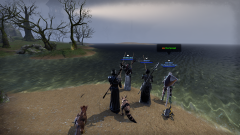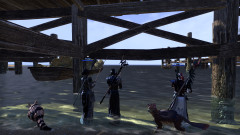-
Posts
1100 -
Joined
-
Days Won
1
Content Type
Profiles
Forums
Gallery
Events
Everything posted by ZEE
-
-
Dev diary #124, Part 4 of 4 for Planetary Rework. Hello everyone and welcome to another Stellaris development diary. Today we're going to continue on the topic that we started on in Dev Diary #121: The Planetary Rework coming in the 2.2 'Le Guin' update. As this is a massive topic that affects many areas of the game, we've split it into four parts. Today's part is the last one, in which we'll be talking about how some special empires and planets such as Hive Minds, Machine Empires and Habitats will work under the new planetary rework system. Gestalt Consciousnesses One of the aims of the Planetary Rework was that we wanted to be able to present the different kinds of societies in Stellaris as actually being different on the planet. Under the old system, the planet of a Gestalt Consciousness feels very much like the planet of any other empire, save for a few minor differences such as the fact that the pops don't have happiness. Under Le Guin, this will change considerably, with Hive Minds and Machine Empires getting their own districts, buildings, strata, jobs and planetary mechanics. Hive Minds and Machine Empires share some mechanical differences with normal empires - they do not produce Trade Value and have no internal trade routes (more on this in a later DD), their pops lack Happiness, and instead of Crime they have Deviancy, representing Drones that malfunction or go rogue in some manner. Instead of the normal Strata, pops are generally divided into Simple Drones and Complex Drones, with the previous producing amenities and raw resources and the latter producing research, unity and finished goods. Amenities for Gestalts represents the necessary maintenance capacity required for planet to be functional, and impacts Stability directly instead of affecting Pop Happiness. Stability is still a factor for Gestalts, representing how smoothly the planet is functioning as a part of the collective. A low-stability Gestalt planet will not experience revolts if there are only drones present on it, but it will be impaired in other ways, such as resource production penalties. Gestalts also not produce or require luxury goods, with the sole exception of Rogue Servitors that need it for their bio-trophies. Hive Minds In Le Guin, the planets of Hive Minds are focused around rapid growth. Instead of City districts, Hive Minds have Hive districts that provide a very large amount of housing, and each of their raw resource districts provides three jobs where a normal empire only gets two. Hive Minds use the normal biological Pop Growth mechanic, and can also make use of migration mechanics internally - drones will emigrate from overcrowded worlds and immigrate to worlds with free housing. Hive Minds also have a special building, the Spawning Pool, that provides Spawning Drone jobs which use a large amount of food to increase the rate of pop growth on the planet. Furthermore, Hive Minds have their own set of capital buildings that lack the 'colony shelter' level - a newly colonized Hive Mind planet has a fully functional capital present from day one. All of these mechanics make Hive Minds ideal for a 'wide' playstyle, expanding rapidly and claiming huge swathes of space for the Hive. Machine Empires Machine Empires share some similarities with Hive Minds, but rather than being focused on rapid growth, their primary focus is efficient use of resources. Like the Hive Minds, they have their own version of housing district, the Nexus District, and their resource extraction districts also provide three jobs where normal empires get two, but in addition to this they also have substantial bonuses to finished goods production, with jobs such as the Fabricator being a more efficient and productive variant of the regular alloy-producing Metallurgist. However, this comes at the expense of being unable to naturally produce new pops, having to rely on costly Replicator jobs to construct new drones. Machine Empires are ideal for an empire that wants to be self-sustaining, and truly shine when they have access to numerous kinds of natural resources. Habitats Finally, another mechanic from a previous expansion that is changing considerably in Le Guin is Habitats. Habitats are still acquired and constructed in the same way as before, but rather than being size 12 planets with a handful of unique buildings, Habitats are now a mere size 6 (8 with Master Builders), but have their own entirely unique set of Districts. Rather than building City, Mining, Farming or Generator districts, Habitats have the following districts available: Habitation District: Provides housing Research District: Provides researcher jobs Trade District: Provides trade value jobs (Non-Gestalt only) Leisure District: Provides unity and amenities jobs (Non-Gestalt only) Reactor District: Provides energy-producing jobs (Gestalt only) No matter the type, each District built on a Habitat provides a fixed amount of infrastructure (currently 5, or 1 building per 2 districts). Habitats can support most regular planetary buildings, and so can be further specialized towards for example trade, goods production or research, but lack virtually all ability to produce raw resources. Since research and unity penalties scale towards an empire's number of districts rather than planets in the Le Guin update, they are also highly efficient for tall empires, as Habitat districts provide a larger amount of housing, infrastructure and jobs compared to regular planet districts. (NOTE: This interface is extremely WIP, the finished version will have non-placeholder art and better district number display, among other things) That's all for today! Next week we're finally moving on to the rest of the Le Guin update, starting with the Galactic Market. We may be done talking about the planetary rework (for now), but there's much more to the update we've yet to even begin showing you!
-
No worries! Unfortunately they haven't released a date yet. But I think they're awesome for keeping everyone informed on the coming changes. It's really getting lots of people excited
-

August - Stage 4 [Discussion] "Thrawn" *SPOILERS*
ZEE replied to ZEE's topic in RoH Book Club's Book of the Month
Reading period for this book is over now, what did everyone think? -
-
The time has come for another months read!! For this month I'd like to keep the theme revolving around the idea of Halloween, spooky/horror. This can include zombies, vampires, werewolves, magic, mystery, etc. Tagging the wonderful people on the signup list @RhemaTom @Cyth27@Ellenore@Nyx Let's see some ideas please
-
-
Another teaser from the upcoming update. @SyntheticPlayer @Tzunamis @Azraella @Kriege7 @Elohir @Morgana Ulfwe @RaydenMarz @Darkbringer105 @Tyrtaeus @Phoenix @Marbass @Wavedox777@IntensePrehistoricButerfly @Rumze @Nova05 @Matatomi @ShogunTaira @KalianVan@ZEE88
-
Updated up to this point
- 20 replies
-
- multiplayer
- taglist
-
(and 1 more)
Tagged with:
-
Guildies for the win!
-
Dev diary #123, Part 3 of 4 for Planetary Rework. Hello everyone and welcome to another Stellaris development diary. Today we're going to continue on the topic that we started on in Dev Diary #121: The Planetary Rework coming in the 2.2 'Le Guin' update. As this is a massive topic that affects many areas of the game, we've split it into four parts. Today's part is going to be talking about Happiness, Stability and Crime. Planet Stability In the Le Guin update, Planetary Stability is the most important factor for determining the productivity and prosperity of your planets. Planetary Stability represents the overall political stability on a planet, and is influenced by a large number of factors such as Pop Happiness, Housing, Amenities, Crime and so on. Planetary Stability ranges from 0 to 100% and has a base level of 50%. A Planet that has at least 50% stability will gain bonuses to resource production and immigration pull, while a planet that drops below 50% stability will experience penalties to resource production and increased emigration push. Below 40% stability, unrest events such as hunger strikes, terrorist bombings and so on may start to occur, which can further lower stability down below the threshold for an armed revolt to start. We're still looking into which parts of the previous Unrest events we want to keep, replace, or convert to the new Crime system, so the exact way in which unrest events and armed revolts will work is not fully decided at this point, and we'll likely cover it more in detail in a future dev diary. Pop Happiness and Approval Rating Pop Happiness is a major factor in determining planet stability. Each Planet that contains at least one Pop with free will has a Pop Approval Rating value that is the average happiness of the Pops, modified by their Political Power. Each Pop has a Political Power value that depends on their stratum and living conditions - for example, a Ruler Pop living in a Stratified Economy will have an immense degree of Political Power, and their happiness may be more important than that of even a dozen Worker Pops. However, even Pops with no political power at all can still drag down your Approval Rating, so a planet with a vast mass of angry slaves will need some Rulers to keep them in line. On the individual Pop level, Happiness no longer affects productivity, so to ensure your planets are productive you now only need make sure your Stability level is high, and whether you achieve that stability with a happy populace or ruling with an iron fist is up to your ethics, policies and general playstyle preferences. Individual Pop Happiness is not entirely without effect though, as the happiness of a Pop determines how likely it is to adopt your governing ethics, and also affects how much Crime it generates (see below for further details). Amenities As part of trying to consolidate systems relating to happiness we've added a new value called Planet Amenities. Amenities represents infrastructure, facilities and jobs dedicated to fulfilling the day-to-day needs of the population. In order to not suffer penalties, a planet needs at least as many Amenities as it has Infrastructure, and any Amenities above or below that number cause increased/decreased Pop Happiness, respectively. Capital Buildings and many Ruler jobs produce a base amount of Amenities and may be sufficient for a sparsely populated mining world, but urbanized planets will likely need to dedicate part of their infrastructure to Amenities-producing jobs such as Entertainers to keep the population happy. Many of the things that used to directly increase Happiness in the old Tile system (such as Domestic Servants or certain special buildings) now produce Amenities instead, and direct Happiness-buffing modifiers have been made rare, so keeping your entire population perfectly happy is now something that requires dedication and resources, rather than just a matter of throwing down a couple of buildings and calling it a day. Crime Something else that we wanted to achieve with the new system was to create the potential for social and political unrest without necessarily having it take the form of a direct penalty or revolt, especially on heavily populated worlds. Crime is a value generated by all virtually all Pops with free will, and can vary between 0 and 100% on a planet. Happy Pops produce less crime, while unhappy Pops produce more crime, but only Pops at a perfect 100% happiness produce no crime at all. Crime has no actual direct penalty, but instead may result in events such as smuggler rings or organized crime taking root on the planet. These events and conditions are generally detrimental, but may also open up certain benficial opportunities and decisions that would not be available on a planet with perfect law and order. Nonetheless, a very high level of Crime is generally something to be avoided, as crime can lower stability and also result in Pops leaving their ordinary jobs and moving into special Crime jobs that appear on the planet and which take resources away from your empire rather than producing them. To combat Crime, you can build buildings such as Precinct Districts that create crime-suppressing Enforcer jobs. In general, empires that rely on repression and inequality to keep their Pops in line will need to employ more Enforcers, but there will also be other ways to manage Crime, possibly including ways to integrate the criminal enterprises as a fixture in your society (the exact details on this is still very much something that's a work in progress). That's all for today! Next week we'll continue with the final part of the Planetary Rework dev diaries, on the topic of Machine Empires, Hive Minds, Habitats and other mechanics that are changing alongside the Planetary Rework.
-
DEV Diary #121 Planetary Rework (Part 1 of 4) As taken from an official post on the Paradox Forums https://forum.paradoxplaza.com/forum/index.php?threads/stellaris-dev-diary-121-planetary-rework-part-1-of-4.1115043/ Hello everyone and welcome to another Stellaris development diary. Today, we're going to start talking about the Planetary Rework coming in the 2.2 'Le Guin' update - the complete redesign of the planetary management system and replacement of planetary tiles. This is going to be a really big topic, so we're spreading it out across four dev diaries, with today's dev diary being about Deposits, Buildings and Districts. Please bear in mind that everything shown is in an early stage of development, and there will be rough-looking interfaces, placeholder art, non final numbers and all those things that people assume are final and complain about anyway no matter how many of these disclaimers I write. Planetary Rework Before I start going into details on the actual rework, I just wanted to briefly talk about the reasons and goals that are behind this massive rework, and why we're removing tiles and building a new system instead of iterating on the existing systems. For me, getting away from the constraints of tiles has been my single most desired long-term goal for the game. It's not that I think the tile system is inherently a bad system - it works well to visualize your pops and buildings and for the early game it works well enough in giving the player some interesting economic management decisions. However, the tile system is also very constrictive, in a way I feel is detrimental to the very core concepts of Stellaris. The hard limitation of one pop and one building per tile, as well as the hard limitation of 25 tiles/pops/buildings to a planet, it severely limits the kind of societies and planets that we can present in the game. Do we want to make city-planets, with enormous numbers of pops concentrated onto a single world? Not possible. Do we want to have a fully automated post-scarcity empire where robots do all the actual work? Can't be done without losing out on valuable building space. Sure, we could fundamentally alter the tile system in a such a way to allow these, by for example making it so each tile could support several sub-tiles with additional pops and buildings, but by doing this we will inevitably lose the easy visual presentation that makes the system attractive to begin with, and even then we would continue to be held back by the limit of one pop per building. In other words, we'd end up with something that superficially might resemble the old tile system but offers none of its main advantages and continues to be held back by most of its drawbacks. When designing the new planetary management system we set out a number of design goals: - The new system should be able to simulate a wide variety of different societies, to build on the roleplaying and diversity in play-throughs that is such a fundamental part of the Stellaris experience - The new system needed to offer more interesting choices about how to develop your planets, while simultaneously reducing the amount of uninteresting micromanagement such as mass-upgrading buildings - The new system should make your planets feel like places where Pops actually live their lives, as opposed to just being resource gathering hubs - The new system had to be extremely moddable, to make it easier both for us and modders to create new types of empires and playstyles We believe that this new system that we have created will not only vastly improve many of the features in the game that we couldn't get working properly with the tile system, but together with the resource rework discussed in the last dev diary will also make it possible for us to create truly weird and alien societies that play entirely differently from anything the game currently has to offer, or would ever have to offer if we had remained constrained by the tile system. Deposits Under the old tile system, deposits were simply clumps of resources placed on a tile, which would be gathered by a pop and determined what kind of buildings were most efficient to place there. Under the new system, deposits are more akin to planetary terrain and features. Every habitable planet will have a (semi-randomized) number of deposits, with larger planets usually having more deposits. Deposits represent areas on the planet that can be economically exploited, and most commonly increase the number of a particular District (more on this below) that can be build on the planet. For example, a Fertile Lands deposit represents various regions of fertile farmland, and increases the number of Agriculture Districts that can be built on the planet, and thus its potential Food output. (Note: All deposit pictures shown here are placeholders, there will be new art for them that isn't done yet) Not all Deposits affect Districts however - some (such as Crystalline Caverns or Betharian Fields) are rare deposits that allow for the construction of special Buildings (more on this below) on the planet, while others yet may simply provide a passive benefit to the planet, such as a spectacularly beautiful wilderness area that increases happiness for Pops living on the planet. Deposits can have Deposit Blockers that work in a similar way to the Tile Blockers of old, cancelling out the benefits of the Deposit until the Blocker is removed through the expenditure of time and resources. A planet can have multiples of the same Deposit, and there is no hard limit to the number of Deposits that a planet can hold (though there is a cap to how many will be generated under normal circumstances). The types of Deposits that can show up on a planet is affected by the planet class, so where an Ocean World might get its Agriculture from Kelp Forests, an Arctic World would have Fungal Caverns instead. (Note: All deposit pictures shown here are placeholders, there will be new art for them that isn't done yet) Districts Districts are at at the core of how planets are developed in the Le Guin update. Districts represent large areas of development on the planet dedicated towards housing or resource gathering. For most empires, there are four basic types of Districts: City Districts, Mining Districts, Generator Districts and Agriculture Districts. There are exceptions to this (such as Hive Minds having Hive Districts) but more on this in a later DD. The total number of districts you can build on a planet is equal to its size, so a size 16 planet can support 16 districts in any combination of the types available to you. Additionally, the resource-producing districts (Mining, Generator and Agriculture) are further constrained by the Deposits on the planet, so a planet might only be able to support a maximum of 8 Mining Districts due to there simply not being any further opportunities for mining on the planet. City Districts are never limited by the deposits on the planet, so you can choose to forego a planet's natural resources and blanket it entirely in urban development if you so choose. The effects of each District is as follows: City District: Provides a large amount of Housing for Pops, Infrastructure for Buildings and Clerk Jobs that produce Trade Value and Luxury Goods Mining District: Provides a small amount of Housing/Infrastructure and Mining Jobs that produce Minerals Agriculture District: Provides a small amount of Housing/Infrastructure and Farming Jobs that produce Food Generator District: Provides a small amount of Housing/Infrastructure and Technician Jobs that produce Energy Credits There will be more details on most of the concepts mentioned above coming in the other dev diaries. For now, suffice to say that the way you develop your planets with Districts will shape that planet's role in your empire - a heavily urbanized planet will be densely populated, supporting numerous Buildings and specialist Pop Jobs such as Researchers and providing Trade Value for your empire's trade routes (more on this in a future DD), but at the expense of not being able to produce much of the raw resources that are needed to fuel your empire's growth and manufacturing capacity. A planet's Deposits and Planetary Modifiers may influence this decision - a large planet with High Quality Minerals and numerous Mining Deposits will certainly make for a lucrative mining world, but what if it also sits in a perfect spot to make a heavily urbanized trade hub? No longer are choices regarding planets simply limited to 'Where do I place the capital for the best adjacency bonuses?' and 'Should I follow the tile resource or not?' but will be fundamental choices that create diverse and distinct planets that each have their own role to fill in your empire. Buildings In the Le Guin update, Buildings are specialized Facilities that provide a variety of Jobs and Resources that are not suitable to large-scale resource gathering. For example, instead of having your scientists working in a Physics Lab on a Physics Deposit (whatever that is supposed to be...) you now instead construct a Research Labs building (representing not a single laboratory but rather an allocation of resources towards the sciences across the planet) which provides a number of Pop Researcher Jobs that conduct research for your empire. Buildings are limited by the planet's Infrastructure, with one building 'slot' being unlocked for each 10 Infrastructure on the planet. Some Buildings are also limited in the number you can build on a planet, while others can be built in multiples (for example, a planet can only support a single Autotchton Monument, while you can have as many Alloy Foundries as the slots allow). Buildings can still be upgraded to more advanced versions, but generally there will be far fewer upgrades to do and those upgrades will often require an investment of rare and expensive resources, so it's more of an active choice than something you simply have to click your way through after unlocking a tech. Infrastructure comes primarily from constructing Districts, with City Districts giving much more Infrastructure than resource gathering districts do (6 as opposed to 2 in the current internal build, though non final numbers and all that). In addition to unlocking additional Building slots, a higher Infrastructure level also makes some Buildings more efficient, as the number of jobs they provide is fully or partially determined by the planet's Infrastructure level. For example, in the current internal build, Research Labs and Alloy Foundries both have the number of jobs they provide determined by the infrastructure level, meaning that concentrating your research and manufacturing to your heavily urbanized planets is generally more efficient than trying to turn your agri-worlds into science hubs. In addition to Buildings that provide resource-producing Jobs, there is also a wide variety of buildings that provide for the material and social needs of your Pops, such as Luxury Housing for your upper class Pops, Entertainment Buildings to make your populace happy and Law Enforcement to quell unrest and crime. Densely populated planets tend to require more such buildings, as the need for Housing and Amenities scales upwards with Pops and Infrastructure. Whew, that was a lot of words. Still, we're only just getting started on the Planetary Rework and next week we'll continue talking about it, on the topic of Stratas, Pop Jobs, Housing and Migration. DEV Diary #122 Planetary Rework (Part 2 of 4) As taken from an official post on the Paradox Forums https://forum.paradoxplaza.com/forum/index.php?threads/stellaris-dev-diary-122-planetary-rework-part-2-of-4.1115992/ Hello everyone and welcome to another Stellaris development diary. Today we're going to continue on the topic that we started on in last week's dev diary: The Planetary Rework coming in the 2.2 'Le Guin' update. As this is a massive topic that affects many areas of the game, we've split it into four parts. Today's part is going to be talking about Pop Jobs, Strata, Housing, Growth and Migration. As before, any screenshots are likely to feature placeholder art, unpolished interfaces and non-final numbers. Pop Jobs In the Le Guin update, Jobs is the main way through which resources are produced on planets. Jobs come in two main types, Capped and Uncapped. Capped Jobs are Jobs that are limited by what the planet can offer, for example, you can only have as many Pops working in mining as you have Mining Jobs from Mining Districts. Uncapped Jobs, on the other hand, can always be worked by a Pop that fulfills the requirements, but generally require a specific trait or species right setting. For example, a species that is set as Livestock will work in a special Livestock Job that requires no upkeep, produces food each month and makes the Pop working it require very little Housing (more on that below). Pops will automatically fill empty Jobs that they are capable of holding, and each Job has weights that make them more or less suitable for a specific Pop - an Industrious Pop will be preferred over a non-Industrious one for a job that produces Minerals, for example. Pops that are more suitable for a Job than the current Pop holding the Job may take it from it them, so constructing a bunch of Robot Pops with mining equipment will likely see your organic Miners losing their jobs in short order. The player can set the priority of specific Jobs, ensuring some Jobs are always filled before others, but there is no manual assignment of specific Pops to specific Jobs, as that is one of the more micromanage-y aspects of the old tile system that we wanted to get away from. In addition to resource production, there is also a wide variety of Jobs related to administration and tending to the needs of other Pops. For example, Clerks are service industry workers, 'Space Baristas' that produce a small number of luxury goods and increase the Trade Value of the planet as a result of domestic economic activity in your cities, while Enforcers are your police, working to suppress dissent and reduce Crime on the planet (more on that next dev diary). Some Jobs are rarer than others - Crystal Miner Jobs are only possible on planets that have Rare Crystal deposits, and some anomalies add unique planetary features that create Jobs which might only exist on that particular planet. Some Empires, such as Hive Minds and Machine Empires, also have their own special Jobs that are not available to others. Jobs are fully moddable and come with auto-generated modifiers and functions that make them very easy for modders to add to planets. Strata and Unemployment Whether or not a Pop holds a Job, the vast majority of Pops will belong to a Stratum, representing social classes and other broad segments of the population. The exact Strata that exist in an empire depend on the type of Empire you're playing, but for regular (non-Gestalt) empires, the population will usually be divided into the following three categories: Rulers: This stratum represents the government and wealthy elite. Ruler Pops have a much greater impact on Stability (more on this in next dev diary) than the other two classes and require a great deal of Luxury Goods to stay happy. Specialists: This stratum represents the educated population working in more prestigious and highly paid jobs. Specialist Pops typically work with refining resources or performing intellectual tasks, and require more Luxury Goods than workers in order to stay happy. Workers: This stratum represents the vast majority of the working population. They generally work with raw resource production and require fewer Luxury Goods than Rulers and Specialists. In addition to these three, there are certain special Strata for Pops that fulfill specific conditions, such as the Slave stratum for enslaved Pops. Slave Pops usually require no or almost no luxuries, but are generally only able to hold Worker-class jobs. Each Job is associated with a specific Stratum (such as Ruler Stratum for Administrators and Nobles), and a Pop that takes that Job will usually be instantly promoted to said Stratum. However, while promotion of Pops to a higher Stratum may be quick and painless, demotion is not. A Pop that becomes unemployed will keep the Stratum of the Job that it used to occupy, and will refuse to take a Job from a lower Stratum, even if there are open Jobs available. Over time, these Pops will demote down to a lower Stratum, but as Unemployment can cause quite a bit of unhappiness, having unemployed upper class Pops can be a serious source of instability for a planet while those Pops are demoting. This effect is more pronounced in a stratified empire, as the lack of social safety nets increases the Happiness penalties for unemployment. Housing One of the major reasons we decided to rework the tile system was the limitations it placed on planetary populations - not just limiting us to an absolute maximum of 25 pops, but also ensuring that planets could never be over- or underpopulated, as the ideal number of Pops on a planet would always be equal to the number of tiles. In the Le Guin update, the hard restriction of one Pop per tile has been replaced with a soft cap known as Housing. Housing is a value on the planet that is primarily provided by Districts, with City Districts giving far more Housing than their resource-focused alternatives. Each Pop requires 1 unit of Housing by default, though the Housing demands of individual Pops can change due to a wide variety of factors such as Traits, Stratum, Job and so on. For example, a Robot Pop that is not sapient or has not been given Citizen Rights requires far less housing than an ordinary Pop, as the storage and support infrastructure they require occupies significantly less space on the planet than the dedicated housing occupied by your citizens. Housing is not a hard limit, and the housing requirements of Pops can exceed the available Housing if the planet population continues to grow without additional Housing being constructed. This is called Overcrowding, and will result in a variety of negative effects such as reduced growth speed and lowered Happiness/stability, but also increases the Migration Push on the planet (more on that below), so a small amount of Overcrowding may actually be desirable on your heavily populated planets in order to grow your new colonies. Growth and Migration Migration is a concept that's never quite worked out to be as interesting as it should be in Stellaris. While there were a lot of mechanics related to how Pops moved and why, these mechanics were quite opaque, and the wholesale movements of Pops that simply packed up and moved to another world resulted in a mechanic that often felt more like a nuisance to the player than anything, as Pops would leave critical buildings on your core worlds untended to in order to settle down on some newly colonized ball of ice on the other side of your empire. For this reason, when reworking the migration mechanics, we decided that the new system would tie more directly into Pop Growth and make it more clear what benefits you were receiving from migration on a planet. Under the new Growth and Migration system, each Planet has five different main variables that determine its demographical direction: Pop Growth, Pop Decline, Immigration Pull, Emigration Push and Pop Assembly. I will go over each of these in turn: Pop Growth: This is the base level of Pop Growth on the planet from natural reproduction and immigration. A Planet will only have a single growing Species at any given time, but is not limited to the Species alreadyliving on the planet - any Species with theoretical access to the planet through migration will be able to start growing on a planet, and when choosing a Species to grow, planets will generally prioritize Species that are under-represented on the planet, meaning for example that an empire with Syncretic Evolution will generally have both its Species growing in turn on any new colonies, instead of being limited to only the Species that they used to colonize the planet. The rights you have assigned to Species will factor into this, so a Species with Full Citizenship will get far higher weight when deciding which Pop to grow next than one that merely has Residence. Habitability is also a major factor. Pop Decline: Pop Decline represents the decline of certain Species on the planet, and usually is a result of shifting demographics or Purging. Overcrowded Planets that have over-represented Species will have those Species begin to decline in numbers and be replaced by newly growing, under-represented Species. This means that planet demographics will change over time, for example having your homeworlds turn more cosmopolitan and multi-species over time as a result of signing Migration Treaties as a Xenophile, or your privileged main species with Full Citizen moving onto conquered planets and replacing the less privileged population already living there as a Xenophobe. Purging a particular species will essentially guarantee that Species' rapid decline, creating massive amounts of Emigration in the form of Refugees if Displacement is used. Immigration and Emigration: Each Planet has an Immigration Pull and Emigration Push value generated by factors such as Housing, Stability, Unemployment and so on. By subtracting Emigration from Immigration, the overall Migration state of the planet is calculated. A planet with more Emigration than Immigration will have faster Pop Decline, but will also 'export' its Emigration value to a general Migration Pool that is distributed among potential immigration targets. Planets with higher Immigration Pull will receive a greater share of this migration, which is converted directly into Pop Growth. Normally, Planets can only send their Emigration to planets in the same empire, but signing Migration Treaties or accepting Refugees will allow you to receive migration from planets outside your borders. Pop Assembly: Pop Assembly represents a planet's capacity for constructing artificial (generally Robotic) Pops and comes from certain Jobs provided by special buildings. Each unit of Pop Assembly provided by Jobs will automatically contribute 1 growth towards the next artificial Pop being built on the planet. A Planet can have both Growing and Assembling Pops, and there is no link between Pop Assembly and Emigration/Immigration asides from the potential for assembled Pops to create overcrowding and unemployment. That's all for today! Next week we'll continue with part 3 of the Planetary Rework dev diaries, on the topic of Happiness, Stability and Crime.
-
-
Announced earlier today, Stellaris is coming to PS4 and Xbox One. https://www.paradoxplaza.com/stellaris-console-edition/STELLARIS-CONSOLE-EDITION.html
-
-

August - Stage 4 [Discussion] "Thrawn" *SPOILERS*
ZEE replied to ZEE's topic in RoH Book Club's Book of the Month
Oh no, not less pew pew.. I'm still just getting going in this one. Having trouble finding the time to read this month -















until